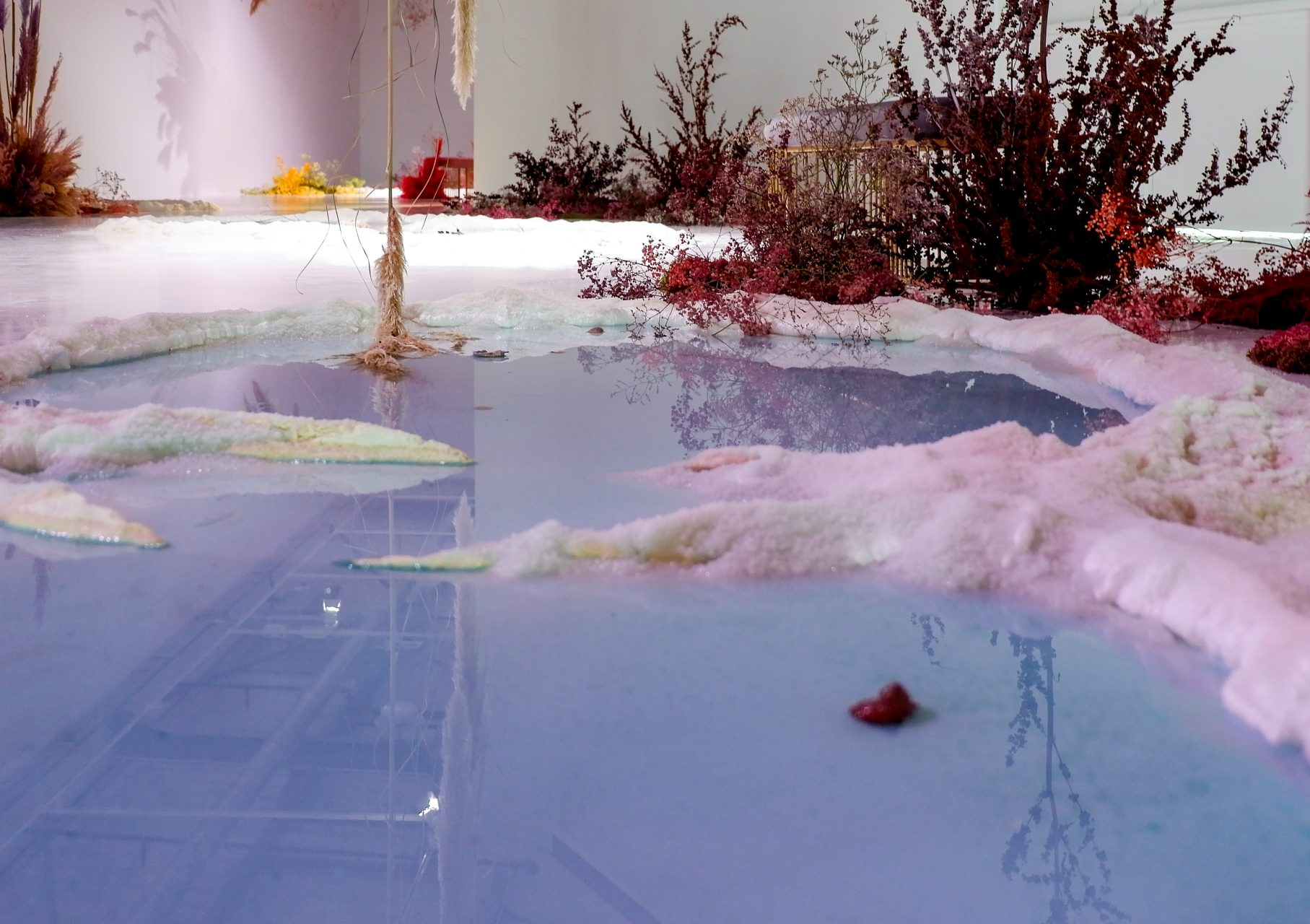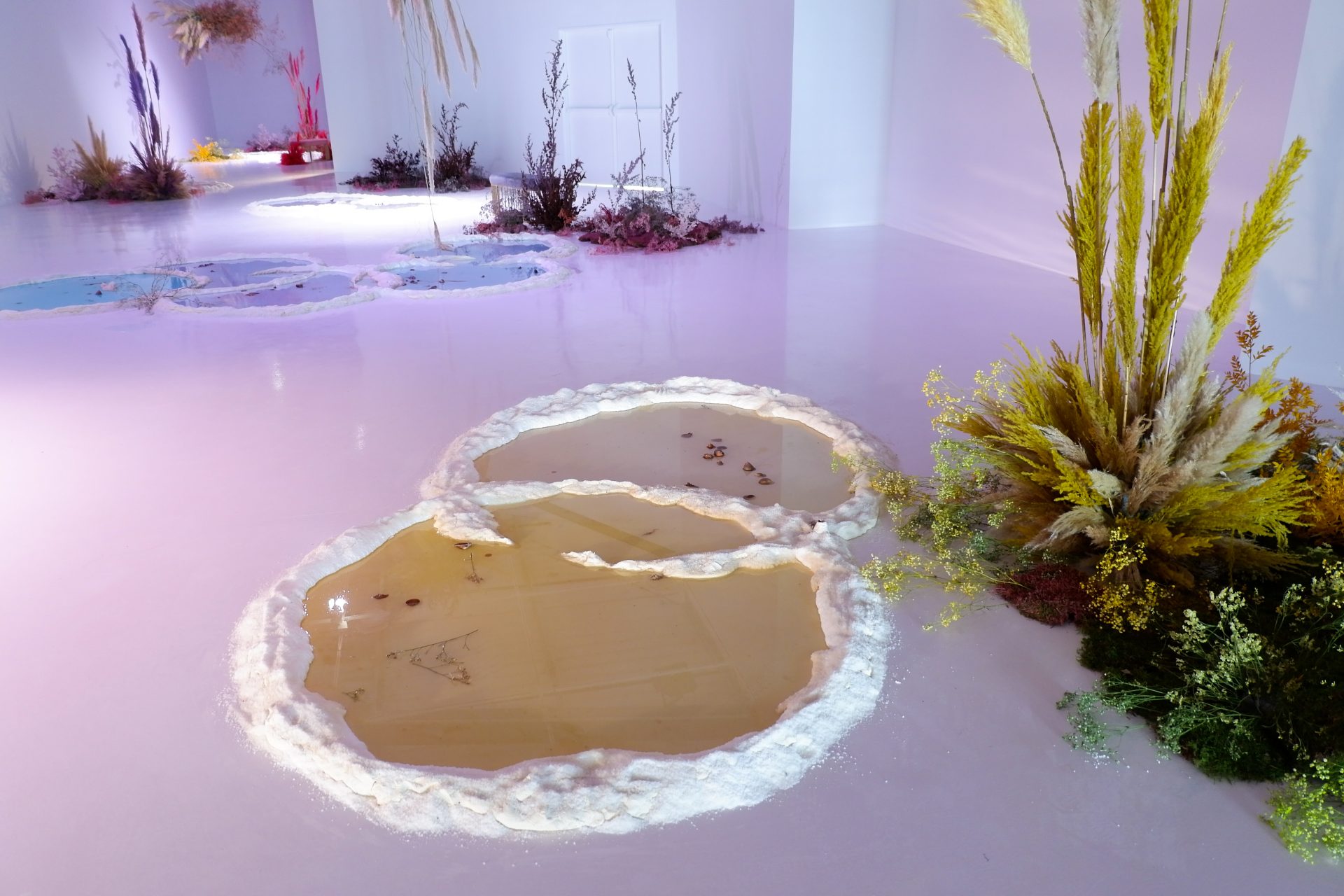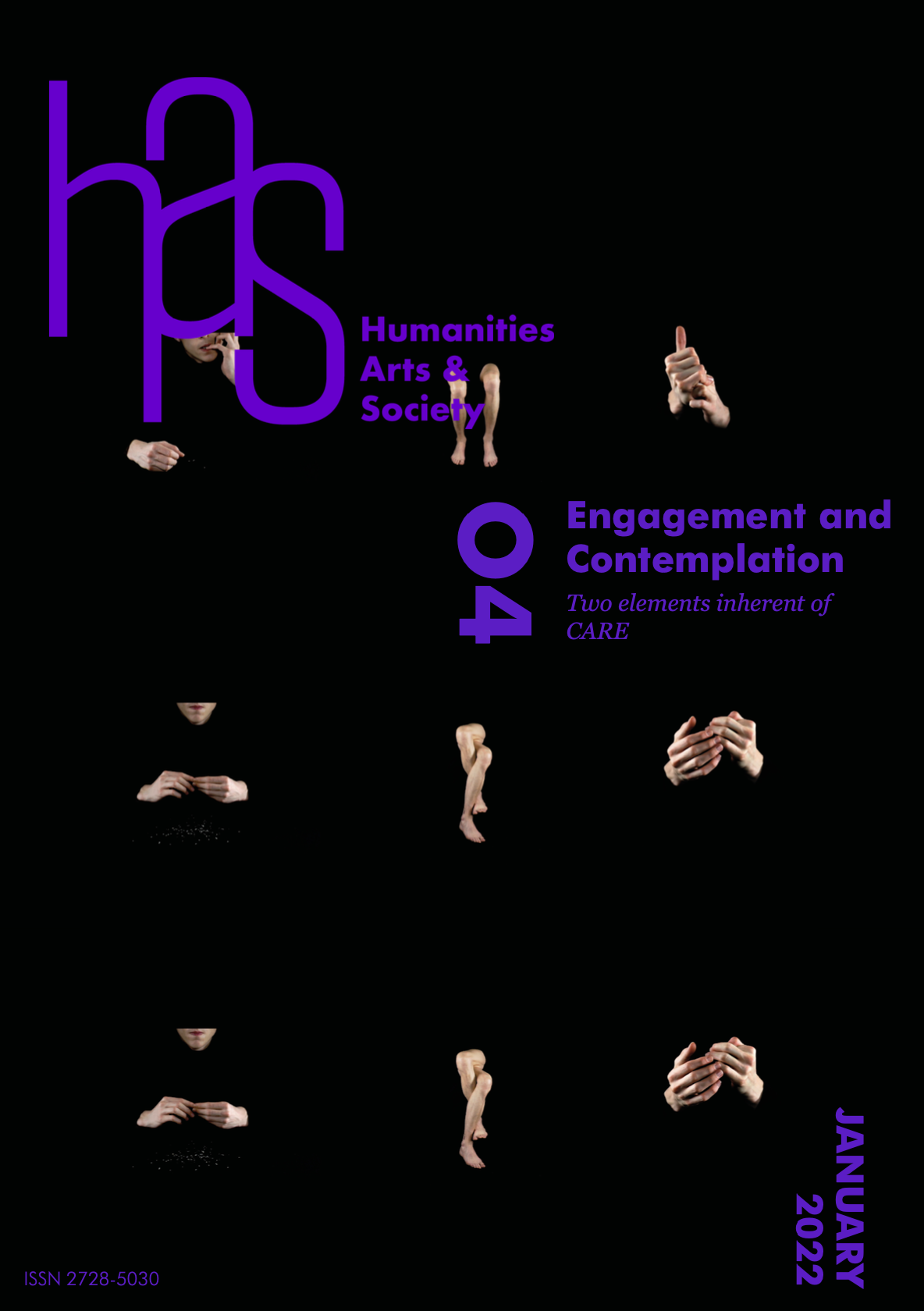
Photo credit : Bianca Bondi
Courtesy the artist and mor charpentier
In dialogue with the installations
Antechamber and Still Water
by the artist Bianca Bondi
How do we calculate the sphere of our influence? Is the radius given by the strength of our voice, the shape of our mouth, the number of eyes and ears that detect our message?
Confronted by a moral reckoning on a global scale, and crises whose order of magnitude overwhelm our limits of comprehension, how can we as individuals navigate pathways toward meaningful change? When overcome by the weight of a situation, we can be driven to a state of inertia as our only retreat, but are there ways to realistically comprehend and engage in the dialogue toward social change from within the means of our limited perception? The criticality of the situation frequently intensifies the pressure upon the public to act. But the urgency of this imperative, and the focus on proactive methods of involvement, threatens to undermine a more fruitful engagement between an individual and a cause.

Photo credit : Bianca Bondi
Courtesy the artist and mor charpentier
Out of the current climate of information, a rift has manifested in the collective consciousness, displacing our sense of self from our cognitive knowledge of current events. This discordance means that movements in politics, culture, and society are conveyed in narratives whose scale bear no semblance to our personal lives. From the ordered perimeter of our personal affairs, we assume a posture of detached neutrality in all but those issues that we endow with emotional investment. As a result of this framework, our sense of control or accountability as individuals toward issues to which we feel compassionately drawn is perceptually overshadowed by the inadequacy of our means, and our compassion becomes a tragic consequence of the singular body we inhabit.

Photo credit : Bianca Bondi
Courtesy the artist and mor charpentier
Organized efforts to effect societal change reinforce this didactic framework by approaching the public as a collective, with data and statistics that indicate the imperative to act through reason. The dynamic of this address establishes rationality as a principal motive, and the desire to act becomes a social obligation rather than a moral imperative. Meanwhile, the demand for action, given in the rhetoric of campaign material, asserts a vision of ethical identity as the material trace of our impression on the world, the specific shape of our metaphorical footprint on the earth—the ground traversed, walls marked, and words spoken.
The urgency of this rhetoric and the irrefutable nature of the issue is given as precedent to offer our bodies to the cause, but when told that we must care and must act, we are denied the tools to engage of our own initiative. In collapsing the space with which to discover a personal relation to the cause, we forego the opportunity to generate solutions that approach the given needs with the specific flavour of our means.

Photo credit : Bianca Bondi
Courtesy the artist and mor charpentier
To render societal-scale issues approachable to individuals, it becomes helpful to deploy a scalable index for modelling the impact of behaviours in a given context. The weight and texture of a metric such as our carbon footprint renders abstract concepts tactile, and more perceptually accessible. However, in this mechanical reduction, we lose sight of the connective tissue of patterns and correlations that underpin the motives behind our behaviour. Especially in human relations, overreliance on objective data can obstruct access to the fundamental structure by focusing too narrowly on the splice of a shifting body. Ideologically, this also upholds the notion that our impact can be defined, in quantifiable terms, as the sum of our actions. For a more comprehensive understanding of our potential contributions, rather than being reduced to our effect, we must realize the fullness of our impressions as agents of causation by embracing the more subjective qualities of our experience.

Photo credit : Bianca Bondi
Courtesy the artist and mor charpentier
We furnish the cornerstone of our humanity by the moral imperative to intervene in circumstances of injustice or wrongdoing, but in centralizing the act as a mode of engagement, our sensitivity to an unjust situation becomes subject to the distortion of a solution-oriented lens. Given in these terms, the complex subtleties of a subject are reduced to their most effective line of compatibility with our means of address, and we approach them as instrumental agents of change rather than with attentive dialogue. To realize the most potent expression of our contribution, we must suspend our proclivity to dominate the narrative with the flavour of the ego, and release the personal notion of our proportionate role or responsibility in events. By allowing things to reveal themselves on their own terms, in languages local, foreign, feathered, winged, or tusked, we embark upon a reciprocal engagement and dynamic relationship with other agents of experience. Simply through the medium of our reception, the voice of the cause garners power and momentum as an agent of effect.
We listen to receive in an open and active state of awareness, and within the act, we acknowledge the incompleteness of our access to the issue as a whole. With this realization, the distance is created for solutions and connections to emerge in the grounds of this new locality—the discourse between our circumstance and the situation. From this perspective, we detach our grasp on realizations at the level of the ego, submitting our efforts to a more holistic vision of betterment as a trajectory rather than a destination. This shift serves to empower individual acts by integrating them into the forceful momentum of participatory change. Liberating ourselves from the conceptual silhouette of our operative function, the axis of intention shifts from breadth of impact to depth of engagement, and we are free to explore a broadened conception of our roles.

Photo credit : Bianca Bondi
Courtesy the artist and mor charpentier
With a renewed clarity of purpose, we can then re-enter the domain of our involvement in a cause. Released from the bond of personal obligation, our empathic intuition remains as a reminder of a deep-rooted connection between our bodies and the events around us. The direct, visceral rumbling of another’s pain, through the channel of our nerve endings, evidences the transcendent nature of our sensory network.
Suddenly, our fallacy of the ego as a free, autonomous, and independent entity is pierced, and the surface of our sensory network extends into a primordial ground. Invoked in the chasm between our vision of how things should be and the image of the world presented to us, injustice manifests in a surge of primal sensation whose depth cannot be deduced through logic or reason. We are brought into direct contact with the larger body, whose clarity of vision unites our experience of self with others, internal with external.
In this reaction, we discover the radiant potential of our voice in manifesting change. Giving ourselves to this introspective experience, our vulnerability is rewarded with insight. The practice of hosting empathy and compassion allows things to converge in the passage of our bodies, crafting the instrumental effect of an acting body.

Photo credit : Bianca Bondi
Courtesy the artist and mor charpentier
The actions, behaviours, words, and choices we make trace the topography of our inner landscape of values and beliefs. By holding ground and learning through our senses, we facilitate the construction of meaningful form in mind and matter by forging the emotional pathways that cultivate this inner landscape. Through this process, our values crystallize into mindful structures and habits that reverberate into our material impact on the earth. To condition the causal agents of our intuition, our behaviours will embody these values and permeate into every quality of our being. In so doing, the paradigmatic prism of our compassion becomes a living, emanating force for other such agents of causation.
Though introspection is viewed as the antithesis of action, the groundwork laid in this process is essential to the generation of lasting and sustainable solutions, and from here our efforts become imbued with radiant potential. Through a personal inquiry, we strengthen our understanding of the issue, and uncover the pre-existing structures or ideologies that uphold the current system—whether mental, physical, institutional, or individual in nature—allowing our energy to be efficiently directed toward their dismantlement. Self-reflection and analysis are integral components, as frequently we trace the tectonic fault lines to beneath our own feet.
It takes strength and courage to care in matters in which we know the ego will never be satiated. In situations that seem out of our control, our survival mechanisms of self-preservation seek closure, through numbness, apathy, or distraction. But to thaw ourselves from this sanctuary, to allow our motions to be guided by the tempestuous pulse of our passions whose rhythm spells hope and vision, is our secret, dormant power. We must learn the tools and techniques to hold our abundant emotions at bay, harness the full power of their teachings, and develop responses that unite the inner and outer worlds of our experience.
Kezia Mclean is an artist whose work centres on themes of philosophy, phenomenology and ecology, and the threads that bind the human to the more-than-human world. Her practise of the craft of drawing instigated a curiosity for aesthetic theory and the ideological foundation of perception. From this, emerged a line of enquiry into the nature of experience, and modes of expression that acknowledge the reciprocity of sensation in the natural world. This ongoing exploration has materialised into a variety of interdisciplinary forms, including abstract drawings and creative writing pieces, focussed on the creative connections between scientific and experiential discourses.
Bianca Bondi (Johannesburg, South Africa, 1986) lives and works in Paris. Multidisciplinary, her practice involves the activation or elevation of mundane objects through the use of chemical reactions, most often by salt water. The materials she works with are chosen for their potential for mutation or their intrinsic and symbolic properties. Her aim being to promote experiences beyond the visual and advocate the life of matter with an emphasis on interconnectivity, transience, and the cycles of life and death. Passionate about ecology and the occult sciences, Bianca Bondi combines the two resulting in pluridisciplinary works of a transformative nature through which the aura of objects is key. Often site specific, the poetic results are very much connected to the places in which they are to exist.
Kezia Mclean is an artist whose work centres on themes of philosophy, phenomenology and ecology, and the threads that bind the human to the more-than-human world. Her practise of the craft of drawing instigated a curiosity for aesthetic theory and the ideological foundation of perception. From this, emerged a line of enquiry into the nature of experience, and modes of expression that acknowledge the reciprocity of sensation in the natural world. This ongoing exploration has materialised into a variety of interdisciplinary forms, including abstract drawings and creative writing pieces, focussed on the creative connections between scientific and experiential discourses.
Bianca Bondi (Johannesburg, South Africa, 1986) lives and works in Paris. Multidisciplinary, her practice involves the activation or elevation of mundane objects through the use of chemical reactions, most often by salt water. The materials she works with are chosen for their potential for mutation or their intrinsic and symbolic properties. Her aim being to promote experiences beyond the visual and advocate the life of matter with an emphasis on interconnectivity, transience, and the cycles of life and death. Passionate about ecology and the occult sciences, Bianca Bondi combines the two resulting in pluridisciplinary works of a transformative nature through which the aura of objects is key. Often site specific, the poetic results are very much connected to the places in which they are to exist.
